List of Authors
>>About this blog
Recent blog post
|
[Silver]
January 17, 2014 14:00
This year's Tokyo Marathon 2014 will be held on February 23.
Prior to that, the marathon course was divided into five sessions, from Saturday, January 25 to February 22.
Every Saturday we visit historic sites and shop at the shopping streets of the course.
There is an  event to walk event to walk happily happily  and healthily. Participation fee is free and healthily. Participation fee is free , but you need to apply in advance. , but you need to apply in advance.
The cost of shopping etc. is borne by the individual, but in Chuo-ku edition, you drink amazake and buy puppet ware in Ningyocho.
In Tsukishima, you can eat lunch such as monjayaki, and buy specialty lever fry and long-established Japanese sweets.
Please click here for more information. /archive/2013/02/post-1546.html
/archive/2013/02/post-1553.html
Click here to apply for the event  and flyer. and flyer.
http://tcgc.5.pro.tok2.com/event/Marathon%202014.pdf
[Satoken]
January 17, 2014 09:00
The year has changed, and the New Year's mood has come out. Early in the new year, or at 0 o'clock on New Year's Day, I went to a nearby shrine with my family.
This is Mr. Konpira of Shinkawa. I went to the neighborhood association to see the amazake get.
It would be the officers of the Neighborhood Association, but I thought it was thankful.
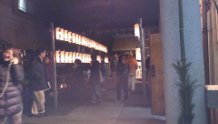 In addition to amazake, it was a red and white steamed manju of Suiedo, famous as oranges. It was very delicious. In addition to amazake, it was a red and white steamed manju of Suiedo, famous as oranges. It was very delicious.
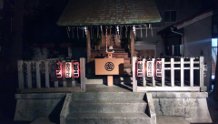 At the neighborhood association, portable shrine also has a festival. I thought I would try to carry it this year. At the neighborhood association, portable shrine also has a festival. I thought I would try to carry it this year.
On the way home, I visited Oiwa Inari.
[Apricot peony]
January 16, 2014 14:00
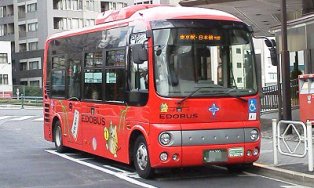 The community bus "Edo Bus" in Chuo-ku is a cute bus with a comical cat. The community bus "Edo Bus" in Chuo-ku is a cute bus with a comical cat.
Starting from the ward office, there are two routes: the north circulation that returns around Tokyo Station, Nihonbashi, and Hamacho, and the south circulation that returns around St. Luke International Hospital, Shinkawa, Tsukuda, Harumi, and Kachidoki. There is.
The fare is 100 yen, and the service is about 1 every 20 minutes.
It is very convenient because it goes to related facilities in the ward, such as the inhabitant of a ward center and senior center, and a place slightly away from the station.
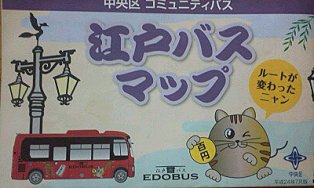
"Edo bus map" which published service route and stop, timetable of this Edo bus is distributed at ward offices, etc., but this is a little Chuo-ku guide.
In addition, the content changes every season, and during the cherry blossom season, the highlights of the cherry blossoms along the line are posted, and the one published in September last year is a stage walk map of movies, dramas, and novels. The Mitsui Main Building in Nihonbashi, which was the location of the headquarters of the Tokyo Central Bank, which appeared in Naoki Hanzawa, was also posted.
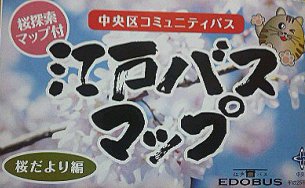 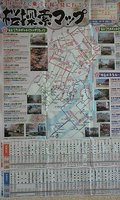
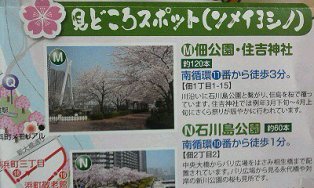 ↑Click it to increase it. ↑Click it to increase it.
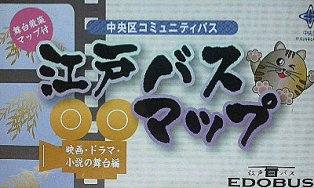 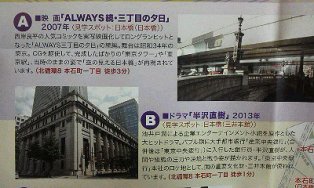
There are many such famous places, so if you purchase a one-day ticket of 300 yen, you can easily visit Chuo-ku.
The season is the coldest time of the year, but how about going around Chuo-ku using the Edo bus instead of just staying at home?
1.
January 16, 2014 09:00
In the New Year, as usual, four seats in Tokyo are competing for early spring play. One of the pleasures is to worry about which one to look at while consulting with your wallet. On the 10th when the pine was removed, we first went to Shimbashi Enbujo. This is a hot topic of the performance of "Keisei" through the new project. It is said to be a combination of Kabuki 18th "Keisei", "Kanba", "Removal" and "Kamabe". I went to the hall with excitement with shrimp fans about what was completed.
What attracts your eyes when you enter is the curtain with shrimp drawn. Certainly, the twelfth generation Danjuro was drawn in commemoration of Ebizo's attack! Something that comes a bit jean to remember. A great success with almost full capacity due to the ability to attract customers. We set up in the middle of the second row for a companion saying, "I want you to look at it and get the energy of this year."
Becomes "Kanba" or hits six parts to Shiro Mihoya and "Kamahige" of "Shikorohiki", "Akoya" is "Oiran Michinaka" (I saw it for the first time), and Funassy and Kumamon are appearing and laughing. The highlight is "Gokuwari", where Tsugaru Shamisen, Osatsuma, and Nagauta compete. A 9-meter-long shrimp appeared and the shrimp could be found on a huge offering rice cake, and the audience was delighted. The last curtain, "Removal," is an interesting taste that creates a "Sansho seat" that imitates the "Arhat seat" of the Edo period on the stage, and 14 people each above and below (2,000 yen). The Sansho seats are in the position of "self watching the stage" and "self seeing" from other customers. It's a short time, but I can't break my seat, so it might be quite tight. 。 。 But the shrimp was a close distance of about 30 cm, so the companion seemed to be "envy."
I enjoyed the gorgeous and grand "first play" like New Year's and went home while saying, "The most fun thing was the shrimp."
Until the 26th of "Shousansho Keisei"
Contact Tickethon Shochiku 9570-000-489
[Tachibana]
January 15, 2014 14:00
Every day, people tend to stay at home due to the cold, but if you take a stroll on a sunny day, how about the Hamacho Ryokudo?
"Hamacho Ryokudo" begins opposite the exit of Hamacho Kiyosubashi in the capital city.
If you dive through an arched tunnel, you will find an almost straight green road sandwiched between roads on both sides.
This is a green road built by reclaiming the place where the Hamacho River (also known as the "Midori River" from the name of the bridge that was built) used to flow.
As you walk north, you will encounter amazake Yokocho, where you will find a statue of Benkei Musashibo, famous for its Kanjin Book (the place where one of the treasure chests of Chuo-ku last year's treasure hunts was located).
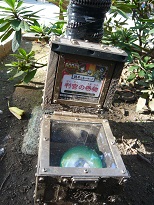
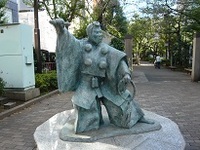
If you go further, there is a monument near the entrance on the north side of the "Place of Rehabilitation of Chinese Medicine".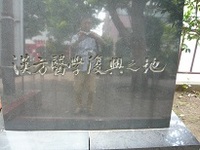
Exit this mouth and pass by the side of the Nihonbashi Fire Station Ningyocho Sub-Branch, and you will come to "Konza-dori" connecting the Hisamatsucho Intersection and Ningyocho Intersection.
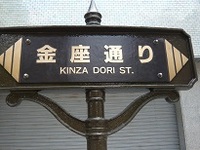 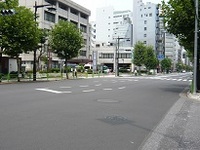
"Koganza-dori" was built to cross the Hamacho River.
And just on the other side of "Konza-dori", there is a monument of "Ogawa Bridge Origin" along with Hisamatsu Police Station.
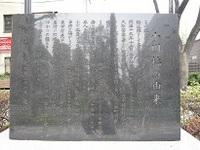
The origin of Ogawa Bridge is that a pistol robbery occurred in Bakurocho in December 1886, and a culprit discovered near Tachibana-cho (currently Higashi-Nihonbashi 3-chome) by Hisamatsu Police Station Ogawa on the way to rushing and seriously injured He was tracked to the banks of Hamacho and caught the man. The criminal had 80 exils, and five were violent criminals killing people.
However, inspector Ogawa (2nd grade advanced due to his arrest) died two years later due to the wound at this time. Therefore, we regretted the precious death of the assistant inspector, named the bridge next to the Hisamatsu Police Station Ogawa Bridge, and decided to leave the immortal achievement for future generations.
I often heard this story from my grandparents born in the Meiji era, but I am a little surprised that there was a violent crime of pistol robbery (although he had even a sword) in Meiji period, but I thought that the bravery of policeman Ogawa who confronted this violent crime alone would have been a great officer for children.
[Mapo ★]
January 15, 2014 09:00
I think it was on the Ginza Times.
I wanted a Ginza map sold at Kyobunkan, so I went there the other day.
It seems that this is the original of Kyobunkan.
It can be folded small (this is called Miura folding) and put it in a bag.
On the back of the entire map, you can see Namiki-dori St., Miyuki-dori, Chuo-dori.
There is also a map of the shops in each street, which is very convenient!
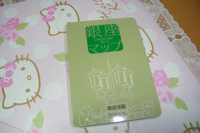
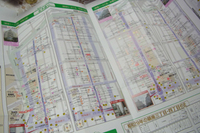 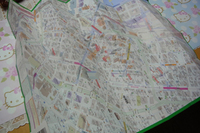
630 yen per one
It is also posted on the website of Kyobunkan.
And the other is the key ring at Ginza Station in Metro. (500 yen per one)
There were also Ginza Line (orange) and Hibiya Line (grey).
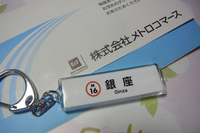 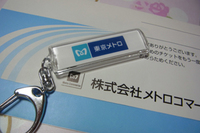
I often come to Ginza on the Marunouchi Line, but if you walk along the underpass from the Metro station, you will find it.
There's a Metro office near 4th Street.
When I went in casually the other day, I saw straps, key rings, calendars, etc.
A lot of goods were on sale.
MetroCommerce website
Since it is LOVE Ginza, I would like to post Ginza goods once I find Ginza goods (* ^^ *)
|
Links
|
![]() event to walk
event to walk![]() happily
happily ![]() and healthily. Participation fee is free
and healthily. Participation fee is free![]() , but you need to apply in advance.
, but you need to apply in advance.![]() and flyer.
and flyer. In addition to amazake, it was a red and white steamed manju of Suiedo, famous as oranges. It was very delicious.
In addition to amazake, it was a red and white steamed manju of Suiedo, famous as oranges. It was very delicious. At the neighborhood association, portable shrine also has a festival. I thought I would try to carry it this year.
At the neighborhood association, portable shrine also has a festival. I thought I would try to carry it this year. The community bus "Edo Bus" in Chuo-ku is a cute bus with a comical cat.
The community bus "Edo Bus" in Chuo-ku is a cute bus with a comical cat.


 ↑Click it to increase it.
↑Click it to increase it.













